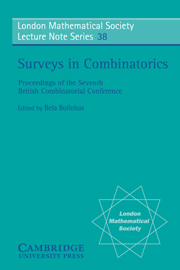Book contents
- Frontmatter
- Contents
- PREFACE
- 1 Resonance and reconstruction
- 2 Symmetry conditions in graphs
- 3 Extremal hypergraph problems
- 4 Connectivity and edge-connectivity in finite graphs
- 5 Partition theory and its applications
- 6 Strongly regular graphs
- 7 Geometries in finite projective and affine spaces
- 8 Long cycles in digraphs with constraints on the degrees
- 9 Colouring problems and matroids
- Index
8 - Long cycles in digraphs with constraints on the degrees
Published online by Cambridge University Press: 17 March 2010
- Frontmatter
- Contents
- PREFACE
- 1 Resonance and reconstruction
- 2 Symmetry conditions in graphs
- 3 Extremal hypergraph problems
- 4 Connectivity and edge-connectivity in finite graphs
- 5 Partition theory and its applications
- 6 Strongly regular graphs
- 7 Geometries in finite projective and affine spaces
- 8 Long cycles in digraphs with constraints on the degrees
- 9 Colouring problems and matroids
- Index
Summary
INTRODUCTION
There is an extensive literature on long cycles, in particular Hamiltonian cycles, in undirected graphs. Since an undirected graph may be thought of as a symmetric digraph it seems natural to generalize (some of) these results to digraphs. However, cycles in digraphs are more difficult to deal with than cycles in undirected graphs and there are relatively few results in this area. In the present paper we review the results on long cycles, in particular Hamiltonian cycles, in digraphs with constraints on the degrees, and we present a number of unsolved problems.
TERMINOLOGY
We use standard terminology with a few modifications explained below. A digraph (directed graph) consists of a finite set of vertices and a set of ordered pairs xy of vertices called edges. If the edge xy is present, we say that x dominates y. The outdegree d+ (x) of x is the number of vertices dominated by x, the indegree d− (x) is the number of vertices dominating x, and the degree d(x) of x is defined as d+ (x) + d− (x).
A digraph D is k-regular if each vertex has degree k and D is k-diregular if each vertex has indegree k and outdegree k. The order of a digraph is the number of vertices in it. When we speak of paths or cycles in digraphs, we always mean directed paths or cycles. A k-cycle is a cycle of length k. A digraph of order n is pancyclic if it contains a k-cycle for each k = 2,3,…,n.
- Type
- Chapter
- Information
- Surveys in Combinatorics , pp. 211 - 228Publisher: Cambridge University PressPrint publication year: 1979
- 6
- Cited by



